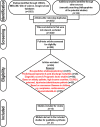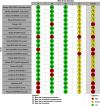Prognostic models for predicting in-hospital paediatric mortality in resource-limited countries: a systematic review
- PMID: 33077558
- PMCID: PMC7574949
- DOI: 10.1136/bmjopen-2019-035045
Prognostic models for predicting in-hospital paediatric mortality in resource-limited countries: a systematic review
Abstract
Objectives: To identify and appraise the methodological rigour of multivariable prognostic models predicting in-hospital paediatric mortality in low-income and middle-income countries (LMICs).
Design: Systematic review of peer-reviewed journals.
Data sources: MEDLINE, CINAHL, Google Scholar and Web of Science electronic databases since inception to August 2019.
Eligibility criteria: We included model development studies predicting in-hospital paediatric mortality in LMIC.
Data extraction and synthesis: This systematic review followed the Checklist for critical Appraisal and data extraction for systematic Reviews of prediction Modelling Studies framework. The risk of bias assessment was conducted using Prediction model Risk of Bias Assessment Tool (PROBAST). No quantitative summary was conducted due to substantial heterogeneity that was observed after assessing the studies included.
Results: Our search strategy identified a total of 4054 unique articles. Among these, 3545 articles were excluded after review of titles and abstracts as they covered non-relevant topics. Full texts of 509 articles were screened for eligibility, of which 15 studies reporting 21 models met the eligibility criteria. Based on the PROBAST tool, risk of bias was assessed in four domains; participant, predictors, outcome and analyses. The domain of statistical analyses was the main area of concern where none of the included models was judged to be of low risk of bias.
Conclusion: This review identified 21 models predicting in-hospital paediatric mortality in LMIC. However, most reports characterising these models are of poor quality when judged against recent reporting standards due to a high risk of bias. Future studies should adhere to standardised methodological criteria and progress from identifying new risk scores to validating or adapting existing scores.
Prospero registration number: CRD42018088599.
Keywords: paediatric intensive & critical care; paediatrics; statistics & research methods.
© Author(s) (or their employer(s)) 2020. Re-use permitted under CC BY. Published by BMJ.
Conflict of interest statement
Competing interests: None declared.
Figures





References
-
- World Health Organization Child mortality rates plunge by more than half since 1990 but global MDG target missed by wide margin, 2015. Available: http://www.who.int/mediacentre/news/releases/2015/child-mortality-report... [Accessed 20 Jan 2018].
-
- Lucia Hug DS, You D. Levels and trends in child mortality: UNICEF, 2019. Available: https://data.unicef.org/resources/levels-and-trends-in-child-mortality/ [Accessed Aug 2019].
-
- World Health Organization Serious childhood problems in countries with limited resources. Geneva, 2004.
-
- World Health Organization Children: reducing mortality, 2017. Available: http://www.who.int/mediacentre/factsheets/fs178/en/ [Accessed 20 Jan 2018].
Publication types
MeSH terms
Grants and funding
LinkOut - more resources
Full Text Sources
Medical
Miscellaneous
